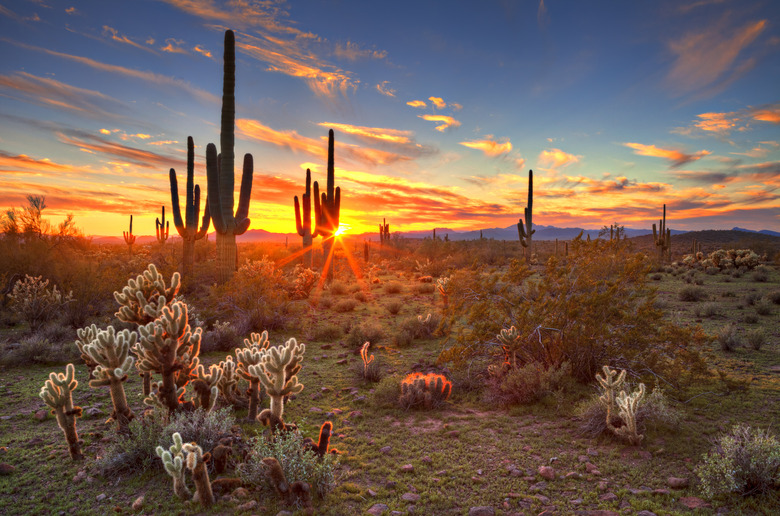Does It Rain In A Desert?
Deserts are regions of the world where a combination of conditions results in an extremely dry and arid biome. A scarcity of precipitation may help fundamentally define that biome and pose a serious challenge to living things, but deserts do receive some measure of rainfall – even if measurable precipitation sometimes only comes every few years, as in the most extreme deserts.
Desert Geography
Desert Geography
The low rainfall amounts deserts experience come from a combination of climate and geography. Most deserts occur between 15 and 35 degrees of latitude, in an area where air circulating out of the equatorial zone descends, warms and absorbs moisture from the land beneath. Many deserts also exist in rain shadows, where a high mountain range to the windward side draws moisture out of weather systems before they reach the leeward side. This results in a biome where water tends to evaporate out quicker than rain can replace it, resulting in an extremely dry environment. The low humidity in the air reduces its ability to moderate temperatures, leading to extremely hot days followed by cold nights.
Rain in Deserts
Rain in Deserts
While there are many different definitions for what constitutes a desert, all involve low rainfall. The United States Geological Survey classifies deserts at two levels: arid lands receiving less than 10 inches of rainfall each year, and extremely arid lands experiencing no rainfall at all for periods longer than 12 months. The driest deserts in the world are the inland Sahara desert in northern Africa and the Atacama desert in Chile, both receiving around 0.6 inches of rain in an average year. In many cases, precipitation events in deserts occur as torrential, if brief, storms.
Effects of Desert Rains
Effects of Desert Rains
When rainfall does occur in the desert, it can result in startling changes in the local conditions. Torrential storms can flood dry riverbeds and wadis, producing flash floods in areas that may not have seen moisture in months. The ground is so dry and porous, however, that it will soak up the water very quickly once the downpour ends. In many cases, the only trace of these desert rainfall events is renewed animal and insect activity, as well as a swift response from local flora, which quickly starts producing seeds and flowers. These, in turn, fuel responses in many desert-adapted animals.
Cold Deserts
Cold Deserts
Not all deserts are hot, baking environments. So-called cold deserts experience low humidity and rainfall like traditional deserts, but their geographic location means temperatures are much lower. Examples include the Gobi Desert of Central Asia and the Great Basin Desert of the western United States, where much of the annual desert precipitation falls not as rain but as snow. Despite persistent snow and ice, much of the Arctic and Antarctic qualifies as desert due to low precipitation; though these regions are certainly cold, they're distinct enough to separately categorize as "polar deserts."
Cite This Article
MLA
Kazmeyer, Milton. "Does It Rain In A Desert?" sciencing.com, https://www.sciencing.com/rain-desert-3985/. 19 April 2018.
APA
Kazmeyer, Milton. (2018, April 19). Does It Rain In A Desert?. sciencing.com. Retrieved from https://www.sciencing.com/rain-desert-3985/
Chicago
Kazmeyer, Milton. Does It Rain In A Desert? last modified March 24, 2022. https://www.sciencing.com/rain-desert-3985/
